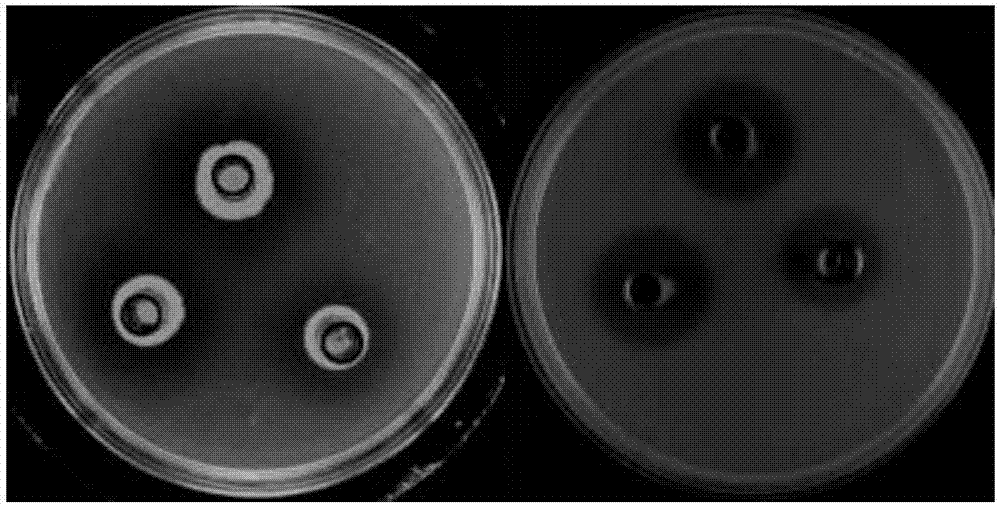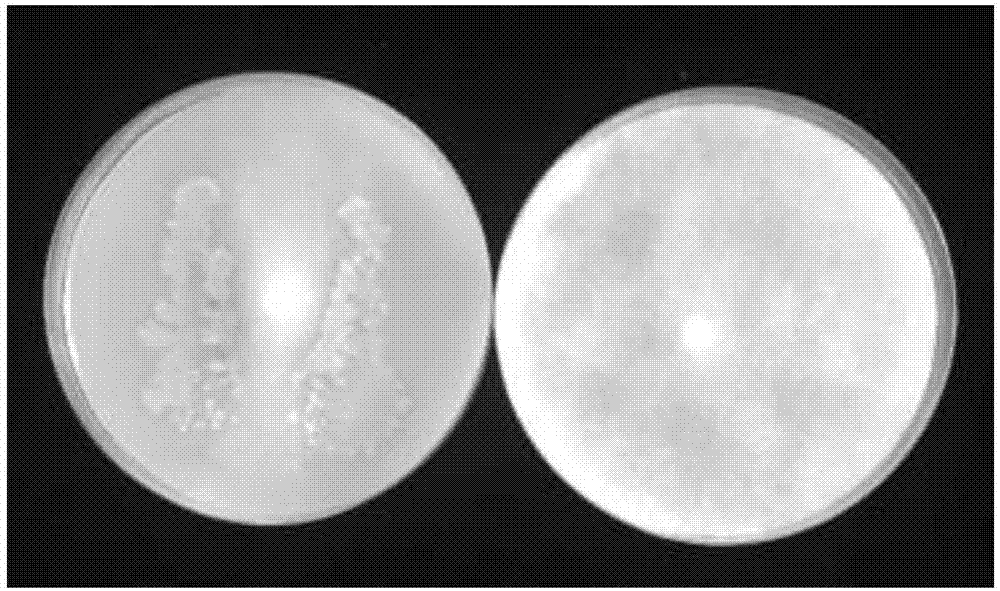Acid-resistant pseudomonas koreensis CLP-7, and applications thereof
A technology of Pseudomonas and CLP-7, applied in the field of microorganisms, has achieved broad application prospects, strong stress resistance, and excellent growth-promoting effects
- Summary
- Abstract
- Description
- Claims
- Application Information
AI Technical Summary
Problems solved by technology
Method used
Image
Examples
Embodiment 1
[0030] Example 1 The antagonistic effect of CLP-7 and its fermentation broth on tobacco bacterial wilt, black shank and brown spot
[0031] Inoculate CLP-7 on NA plates at 30°C for 48 hours, then use the plate confrontation method, that is, inoculate black shank and Alternaria alternata (diameter 5mm) on the oat and potato dextrose medium (PDA) plates. Pick AR03 and streak equidistantly on both sides of the bacterial cake, culture it at 30℃ for 5 days, and use Oxford cup plate diffusion method to inhibit Ralstonia solanacearum; that is, inoculate CLP-7 strain into beef juice peptone liquid culture medium ( NB), 30 ℃, 150 rpm shaking culture for 2 days, take appropriate amount of fermentation broth and sterile supernatant (filtered through a bacterial filter) on the Oxford cup containing Ralstonia solanacearum peptone medium plate (NA) Inside, stand for 2 days and observe the inhibition of CLP-7 on the above pathogenic bacteria. From the observation of the antibacterial effect of...
Embodiment 2
[0033] Example 2 The inhibitory effect of CLP-7 strain on the growth of black shank and Alternaria alternata hyphae
[0034] With black shank and Alternaria alternata as target bacteria, that is, inoculating CLP-7 on NA plates at 30°C for 48 hours, and then using the plate confrontation method, that is, inoculating Alternaria alternata on oat plates and Alternaria alternata on PDA plates. Pick AR03 in the ring and streak equidistantly with the bacterial cake as the center. Incubate at 30°C for 5 days. Pick out the edge hyphae of the black shank and Alternaria alternata respectively under a microscope. The results show that after CLP-7 treatment Compared with normal hyphae, the cytoplasm in the hyphae cells of the black shank fungus cake marginal hyphae aggregates into a spherical shape, which is separated from the cell membrane and cell wall, thus affecting its normal growth ( Figure 4 ); Compared with the normal conidia, the inhibitory effect of the conidia of Alternaria alterna...
Embodiment 3
[0035] Example 3 Determination of Protease Activity of CLP-7 Strain
[0036] The protease activity was determined using protein culture medium. The protein culture medium and formula were: A: 6.4g skimmed milk powder, dissolved in 240mL water, and sterilized at 121°C for 20min; B: agar, 6.4g, constant volume to 240mL, sterilized at 121°C for 20min , A and B are sterilized and mixed separately for protease detection. The measurement method is as follows: the protein medium is dissolved and made into a plate. Take a sterile toothpick to spot the CLP-7 strain on the protein medium plate, culture for 3 days after inoculation, observe the colony growth and the size of the transparent circle, and measure the diameter of the transparent circle R 2 And colony diameter R 1 , Using R 2 / R 1 The ratio qualitatively indicates its protease activity. The results show that( Figure 7 ), CLP-7 strain has protease activity, its enzyme activity size, namely R 2 / R 1 Is 4.10. The protease activit...
PUM
 Login to View More
Login to View More Abstract
Description
Claims
Application Information
 Login to View More
Login to View More - R&D
- Intellectual Property
- Life Sciences
- Materials
- Tech Scout
- Unparalleled Data Quality
- Higher Quality Content
- 60% Fewer Hallucinations
Browse by: Latest US Patents, China's latest patents, Technical Efficacy Thesaurus, Application Domain, Technology Topic, Popular Technical Reports.
© 2025 PatSnap. All rights reserved.Legal|Privacy policy|Modern Slavery Act Transparency Statement|Sitemap|About US| Contact US: help@patsnap.com



